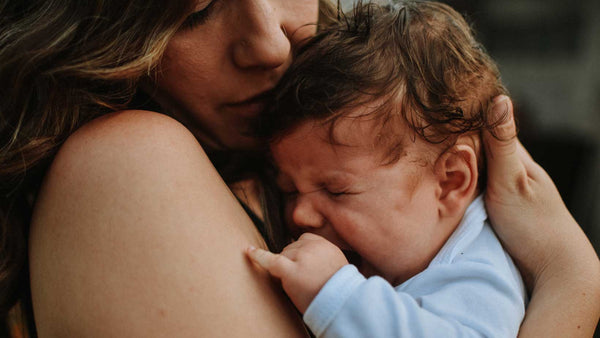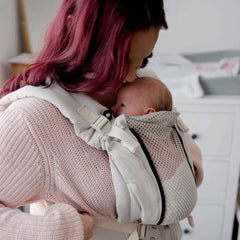
As new parents, we can rapidly feel overwhelmed by our baby’s cries. We don’t always know how to calm them and wonder if it’s normal. We’d like to start by reassuring you and say that this is an issue that every parent deals with. Being able to recognize the situations in which a baby might cry will prevent you from being needlessly alarmed. On the other hand, in some instances, when a baby is constantly crying, inconsolable or that the baby’s behavior towards its own crying has changed, feel free to seek the guidance of a health professional.
Babies’ cries vary according to their needs and emotions. Here are a few reasons why a baby would cry and which can be identified by parents: hunger, sleep, discomfort (ex: a soiled diaper or an uncomfortable environment), colic, pain (ex: from teething) or overstimulation (bright lights, an environment buzzing with activity, etc.). To learn more about it, read this article. Lastly, crying in spells can happen when the baby was confronted with stress or frustration and was unable to express his emotions as it happened by crying.
It’s absolutely primordial and necessary to never leave a baby crying, even when he’s no longer a newborn. Remember that a baby never cries to manipulate you as its brain isn’t developed enough to even know how to do it. In this article, we’d like you to discover several methods which will allow you to soothe your baby when he cries. Again, if your baby’s cries persist in spite of these methods, please seek a doctor’s advice.
I) Respond to your baby's fundamental needs:
A baby has several fundamental needs which need to be addressed for a healthy development and general wellbeing. For example, it’s necessary for him to have a good sleep routine, to be in an agreeable environment, to be properly and regularly fed and to feel clean.
Here are some tips to help you with these:
1) Sleep:
Establishing sleep habits is essential for your little one’s health. Put your baby to bed at regular hours. Before laying him down, plan calming activities as a signal that bedtime approaches, like a lukewarm bath, story time or a lullaby. Have him sleep in a calm environment with minimal noise. The room’s temperature should ideally be set at 20°C (68°F). Having a nightlight in the room could also help lulling your baby into a good night’s sleep. For more advice on the topic, read this article on babies' sleep.
2) Feeding:
Cries of hunger are one of babies’ most frequent means of communication. They should then be fed rapidly. Before they start crying, some signs of hunger can be seen like head sucking motions, head movements to search for their mother’s breast, whining and agitation.
For breastfed infants, skin to skin contact with their mother grants reassurance in addition to nutrition. To help you breastfeed comfortably, read our article on breastfeeding while babywearing. For bottle-fed babies, it’s important to follow a regular feeding schedule and ensure that the formula matches your little one’s nutritional needs.
After feeding, discomfort like colic or gas can happen and be a cause of your baby’s cries. To relieve your baby, hold him up in a vertical position after you’ve fed him and gently rub his belly clockwise or use gentle swinging movements.
Colic tends to happen at the end of the day due to abdominal pain. In this situation, babywearing can be a great solution. By using an ergonomic baby carrier, you’ll be able to keep your baby close to you, which can soothe colic by offering a sense of safety and help free up gas. To learn more on which baby carrier or which baby wrap you should use with a newborn baby, read this article on the topic.
3) Changing diapers:

Changing diapers is a crucial basic component of caring for your baby and plays an important role in his comfort and wellbeing. A baby’s cries can be attributed to a soiled diaper, which can cause sensations of discomfort, irritation or even pain. As a parent, it’s essential that you regularly verify the state of your baby’s diaper and to change it when the time comes. Make sure that your baby is at ease and calm before changing his diaper to minimize his stress and crying.
To practice changing your baby’s diaper, take a look at this article from What to Expect.
II) A few techniques to calm your baby:
It’s easy to calm your baby down in the case of a soiled diaper, sleepiness, or the need to feed. In other situations, like discomfort, fussiness and emotional needs, other methods can be useful.
Here are a few.
1. Basic tricks to soothe your baby:
Each baby is different: some will be appeased by music, others by a lukewarm bath, the comfort of mommy’s arms, etc.. It’s essential to experiment with different approaches to find out what works best with your baby.
Dr. Harvey Karp has defined a method called “the 5 S’s method”.
These 5 S’s reference:
- Sucking: Babies have a succion reflex that can be satisfied with a feeding bottle or a pacifier, for example.
- Swaddle: Envelop your baby in a lightly tightened blanket to mimic the reassuring sensation of still being in your womb.
- Swing: The gentle movement provided with your arms or in a cradle can soothe him when done safely.
- Shush: Whispering can create a calming environment by masking other sounds.
2. How can you appease your baby’s emotional needs?
A baby’s cries aren’t always strictly related to physical needs, as emotions and the need for emotional comfort are just as important. When a baby cries, it might be to express the need for physical contact, the need to interact or to be emotionally comforted. Skin to skin contact, cuddles, babywearing, gentle rocking, and catering to signals of his emotional needs all create a strong emotional bond between baby and parent. This ultimately contributes to the baby’s general wellbeing and helps with calming him down rapidly.
Around 8-12 months, seperation anxiety starts to manifest itself, often as shyness around strangers or a feeling of intimidation when surrounded by new faces or crying as soon as the parents disappear from his line of sight. This feeling is perfectly normal and you can help your child to calm down by using touch as we’ve described earlier.
3. Managing your stress as a parent and taking care of yourself:

When faced with your baby’s crying, it’s normal to feel powerless at times, and especially when your own fatigue wears you down. Let’s start by acknowledging that a baby’s cries are his first means of communication. Keep in mind that crying is temporary as they only occur, generally speaking, during the baby’s first few months and become less frequent as he grows up. Babies are emotional sponges and experience your stress. This can reinforce their own distress and therefore worsen their crying. This makes it essential to find methods to focus on ourselves and calm ourselves down when a situation becomes overwhelming.
You can ask your relatives for help, help professionals’, or look for a group support for parents. Most importantly, remember that in order to best take care of your baby, you must first care for yourself as a parent.
******************
We hope these tips have been useful to you. Don’t hesitate to share your own tricks to soothe your baby on Chimparoo's Facebook page under our post on the topic. It’s a great way to bring your own experience to the table and help other parents just like you. We’d like to underline that there’s no shame in asking for a health professional’s help if you feel the need to. Never hesitate to get the help you need.
Babywearing is one of the solutions to explore to soothe a baby’s cries since it allows you to gently rock your baby and helps to establish a privileged and reassuring contact with your little one.
To learn more about it, read up on the topic with the resources we’ve prepared for you:
- Chimparoo's YouTube channel has loads of demonstrations on how to position your baby in a baby carrier or a baby wrap.
- Read our other blog posts on how to carry a newborn baby, physiological babywearing, or the importance of skin to skin.
- Visit our FAQ where we go through the most common questions on the subject.







Share:
The Hip Carry: Is It for You?
Andréane Loubier, Doula and Babywearing Instructor